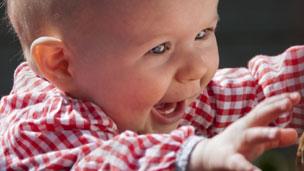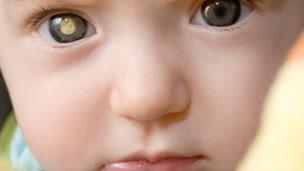'White glow' in babies' eyes a possible cancer warning
- Published

By chance, a friend spotted a glow in Darcey's right eye which led to a cancer diagnosis
Children's cancer campaigners want a section of the personal child health record - or 'little red book' - rewritten to alert new parents to the dangers of an unusual form of eye cancer.
Retinoblastoma, which affects the retina of children aged under five, can result in the eye being removed if there is any delay in treating it.
Spotting the presence of a tumour is key - and sometimes all it takes is a photograph.
The most common sign of retinoblastoma is a white glow in the pupil of the eye, which can look like a 'cat's eye' in a photograph, especially when there is a 'red eye' look in the other eye.
The 'glow' is caused by the light reflecting off the tumour at the back of the baby's eye.
Saving sight
Ali Fryer, mother of Darcey, has the vigilance of a friend to thank for her daughter's diagnosis in February when she was six months old.
"An ex piano pupil of mine saw a tiny glow in Darcey's right eye and suggested I take her to the doctor. I took her there the next morning and our GP sent us straight to eye casualty. It was confirmed that afternoon."
Later, in an effort to thank Ruthie for what she did, Ali asked her to be Darcey's godmother.
Ali had never heard of the condition before and she and her husband had no idea what the future would hold for their daughter. It was a confusing and distressing time.
Chemotherapy at Great Ormond Street Hospital followed and Darcey has regular examinations under anaesthetic at the Royal London Hospital to check on her progress.
"Had the tumour been half a degree bigger at diagnosis, her eye would have been removed immediately.
"At the moment there's a chance that six months of chemo might save it."
One in 20,000
Darcey has around a 50% chance of keeping her right eye. The danger is that a tumour could develop in her other eye too - but this is very rare.
Meanwhile, the chemotherapy treatment is shrinking the tumour and Darcey is coping well with the few side-effects.

An illustration of how retinoblastoma could look in a young baby's eye
"We are prescribed anti-sickness drugs, a lactulose solution to combat constipation, a lovely thick cream for drying skin and as for hair loss - well, she only had a few strands really," Ali says.
The family have community nurses visiting twice a week, monitoring her chemotherapy and carrying out blood tests.
"They are brilliant," says Ali. "They could not make it easier for us."
Retinoblastoma affects one in every 20,000 babies born each year and represents 3% of childhood cancers in the UK.
The good news is that 98% of children treated will survive, but because most cases are not picked up early enough about 80% of children affected will have an eye removed.
Ashwin Reddy, children's eye surgeon and retinoblastoma expert at The Royal London Hospital, says the tumour can kill.
"Spotting the white reflex or white glow in the eye can make a vital difference because the tumour won't be so advanced and we might not have to remove the eye.
"We don't want to panic parents but they can prevent the risk of death by getting their child seen earlier."
No guarantee
The Childhood Eye Cancer Trust are leading the push to make parents more aware of the signs and symptoms of the disease - and they are targeting the 'little red book' and Birth to Five book, both issued to new parents.
Julie Firth, from the cancer trust, says: "The information on childhood eye cancer provided by the NHS for parents is pretty sketchy and non-existent in some places.
"We feel the NHS has a duty to inform parents about the disease to avoid a delay in diagnosis."
While chemotherapy is the standard treatment for retinoblastoma, laser therapy and radiotherapy can also be tried.
A relatively new type of chemotherapy in which the drugs are delivered directly to the eye through an artery in the leg avoids the normal complications of chemotherapy given via a central intravenous line.
But there is still no guarantee that it will be successful.
Children who are unfortunate to have their eye surgically removed can have an artificial eye fitted about six weeks after the operation.
Ali is adamant that anyone can spot the signs of retinoblastoma: "If you see something unusual about a baby or a young child's eye, please take it to the doctor.
"It could well be nothing, and you gain peace of mind. Or it could be something which needs treatment - and if it's retinoblastoma, you may save your child's eyes, if not their life."
- Published14 September 2010